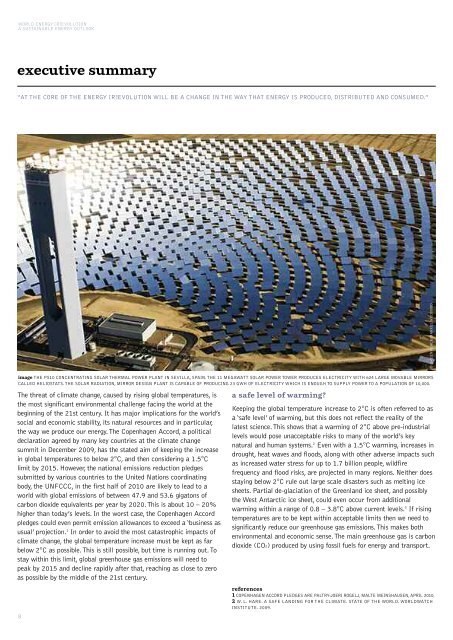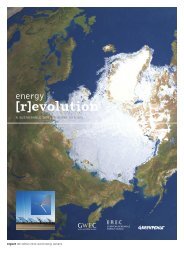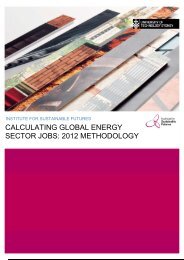download the mexico energy revolution scenario
download the mexico energy revolution scenario
download the mexico energy revolution scenario
You also want an ePaper? Increase the reach of your titles
YUMPU automatically turns print PDFs into web optimized ePapers that Google loves.
WORLD ENERGY [R]EVOLUTION<br />
A SUSTAINABLE ENERGY OUTLOOK<br />
executive summary<br />
“AT THE CORE OF THE ENERGY [R]EVOLUTION WILL BE A CHANGE IN THE WAY THAT ENERGY IS PRODUCED, DISTRIBUTED AND CONSUMED.”<br />
© GREENPEACE/MARKEL REDONDO<br />
image THE PS10 CONCENTRATING SOLAR THERMAL POWER PLANT IN SEVILLA, SPAIN. THE 11 MEGAWATT SOLAR POWER TOWER PRODUCES ELECTRICITY WITH 624 LARGE MOVABLE MIRRORS<br />
CALLED HELIOSTATS. THE SOLAR RADIATION, MIRROR DESIGN PLANT IS CAPABLE OF PRODUCING 23 GWH OF ELECTRICITY WHICH IS ENOUGH TO SUPPLY POWER TO A POPULATION OF 10,000.<br />
The threat of climate change, caused by rising global temperatures, is<br />
<strong>the</strong> most significant environmental challenge facing <strong>the</strong> world at <strong>the</strong><br />
beginning of <strong>the</strong> 21st century. It has major implications for <strong>the</strong> world’s<br />
social and economic stability, its natural resources and in particular,<br />
<strong>the</strong> way we produce our <strong>energy</strong>. The Copenhagen Accord, a political<br />
declaration agreed by many key countries at <strong>the</strong> climate change<br />
summit in December 2009, has <strong>the</strong> stated aim of keeping <strong>the</strong> increase<br />
in global temperatures to below 2°C, and <strong>the</strong>n considering a 1.5°C<br />
limit by 2015. However, <strong>the</strong> national emissions reduction pledges<br />
submitted by various countries to <strong>the</strong> United Nations coordinating<br />
body, <strong>the</strong> UNFCCC, in <strong>the</strong> first half of 2010 are likely to lead to a<br />
world with global emissions of between 47.9 and 53.6 gigatons of<br />
carbon dioxide equivalents per year by 2020. This is about 10 – 20%<br />
higher than today’s levels. In <strong>the</strong> worst case, <strong>the</strong> Copenhagen Accord<br />
pledges could even permit emission allowances to exceed a ‘business as<br />
usual’ projection. 1 In order to avoid <strong>the</strong> most catastrophic impacts of<br />
climate change, <strong>the</strong> global temperature increase must be kept as far<br />
below 2°C as possible. This is still possible, but time is running out. To<br />
stay within this limit, global greenhouse gas emissions will need to<br />
peak by 2015 and decline rapidly after that, reaching as close to zero<br />
as possible by <strong>the</strong> middle of <strong>the</strong> 21st century.<br />
8<br />
a safe level of warming?<br />
Keeping <strong>the</strong> global temperature increase to 2°C is often referred to as<br />
a ‘safe level’ of warming, but this does not reflect <strong>the</strong> reality of <strong>the</strong><br />
latest science. This shows that a warming of 2°C above pre-industrial<br />
levels would pose unacceptable risks to many of <strong>the</strong> world’s key<br />
natural and human systems. 2 Even with a 1.5°C warming, increases in<br />
drought, heat waves and floods, along with o<strong>the</strong>r adverse impacts such<br />
as increased water stress for up to 1.7 billion people, wildfire<br />
frequency and flood risks, are projected in many regions. Nei<strong>the</strong>r does<br />
staying below 2°C rule out large scale disasters such as melting ice<br />
sheets. Partial de-glaciation of <strong>the</strong> Greenland ice sheet, and possibly<br />
<strong>the</strong> West Antarctic ice sheet, could even occur from additional<br />
warming within a range of 0.8 – 3.8°C above current levels. 3 If rising<br />
temperatures are to be kept within acceptable limits <strong>the</strong>n we need to<br />
significantly reduce our greenhouse gas emissions. This makes both<br />
environmental and economic sense. The main greenhouse gas is carbon<br />
dioxide (CO2) produced by using fossil fuels for <strong>energy</strong> and transport.<br />
references<br />
1 COPENHAGEN ACCORD PLEDGES ARE PALTRY-JOERI ROGELJ, MALTE MEINSHAUSEN, APRIL 2010.<br />
2 W. L. HARE. A SAFE LANDING FOR THE CLIMATE. STATE OF THE WORLD. WORLDWATCH<br />
INSTITUTE. 2009.



![Energy [R]evolution - European Commission](https://img.yumpu.com/49109324/1/184x260/energy-revolution-european-commission.jpg?quality=85)


![5905 gp [eu rev]csfr4.qxd - Energy [R]evolution](https://img.yumpu.com/42305023/1/184x260/5905-gp-eu-revcsfr4qxd-energy-revolution.jpg?quality=85)


![5905 gp [eu rev]csfr4.qxd - Energy [R]evolution](https://img.yumpu.com/28729264/1/184x260/5905-gp-eu-revcsfr4qxd-energy-revolution.jpg?quality=85)